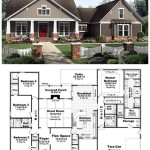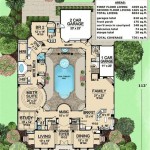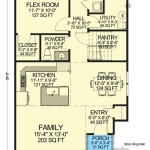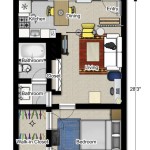3 Bed 2 Bath House Plans Without a Garage: Design Considerations and Alternatives
The decision to build or purchase a home invariably involves careful consideration of numerous factors, including size, layout, and features. Among various house plan options, the 3-bedroom, 2-bathroom configuration is a popular choice, catering to families, couples, and individuals who desire extra space for guests, home offices, or hobbies. However, the inclusion of a garage, while often considered standard, is not always a necessity or a desired feature. This article explores the considerations involved in opting for 3-bedroom, 2-bathroom house plans without a garage, examining the design implications, potential benefits, and alternative solutions for parking and storage.
Choosing a house plan without a garage can significantly impact the overall design and functionality of the home. It necessitates a conscious effort to address the needs typically met by a garage, such as vehicle storage, weather protection, and additional space for tools, equipment, and general storage. By deliberately planning for these functions within the main structure or through external solutions, homeowners can create a living space that is both aesthetically pleasing and functionally efficient.
Space Optimization and Design Flexibility
One of the primary advantages of omitting a garage from a house plan is the increased design flexibility it offers. The space typically allocated for a garage can be repurposed to expand living areas or create new functional spaces. This can lead to a more spacious and comfortable interior, particularly in areas such as the living room, kitchen, or bedrooms.
Furthermore, the absence of a garage allows for greater architectural freedom. The building's footprint can be adjusted to better suit the lot's dimensions and orientation, maximizing natural light and optimizing outdoor living spaces. For example, the area that would have been occupied by a garage can be transformed into a larger patio, deck, or garden, enhancing the home's connection to the surrounding environment.
Inside the home, the space saved can be used in a multitude of ways. A larger kitchen island can be accommodated, creating more counter space and a gathering area. The master bedroom could be expanded to include a walk-in closet and a sitting area. Alternatively, the space could be used to create a dedicated home office, a playroom for children, or a hobby room. The possibilities are limited only by the homeowner's needs and preferences.
In terms of layout, the absence of a garage can facilitate a more streamlined and efficient floor plan. Without the need to incorporate an attached garage and its access points, the interior spaces can be arranged in a more logical and cohesive manner, improving circulation and maximizing usable square footage.
Consider a single-story home where a two-car garage would have consumed a significant portion of the front façade. Removing the garage allows for a wider, more inviting entryway. The front door can be centered, flanked by windows, and potentially even sheltered by a covered porch. This creates a more welcoming and aesthetically pleasing street presence.
Furthermore, homes built on smaller lots or within urban environments often benefit from the elimination of a garage. In situations where space is at a premium, prioritizing living space over vehicle storage can be a sensible decision, allowing for a more comfortable and functional home within the available footprint.
Cost Savings and Construction Efficiency
Constructing a garage adds to the overall cost of building a house. Material costs, labor expenses, and foundation work all contribute to the overall expense. By opting for a house plan without a garage, homeowners can realize significant cost savings, which can be redirected towards other features or upgrades within the home.
The simplification of the building's structure also contributes to increased construction efficiency. Eliminating the garage streamlines the construction process, reducing the complexity of the foundation, framing, and roofing work. This can translate into a shorter construction timeline and lower labor costs.
The savings realized by omitting a garage can be used to enhance other aspects of the home's design. For example, higher-quality materials can be selected for the siding, roofing, or interior finishes. Upgraded appliances, custom cabinetry, or energy-efficient windows can also be incorporated into the design. The money saved on the garage can be strategically allocated to features that will have a greater impact on the homeowner's lifestyle and the home's overall value.
In addition to initial construction costs, the long-term costs associated with maintaining a garage should also be considered. Garages require regular maintenance, including painting, sealing cracks, and repairing or replacing the garage door. These ongoing expenses can be avoided by opting for a house plan without a garage.
Furthermore, homeowners who do not own a vehicle or who rely on public transportation may find that a garage is an unnecessary expense. For these individuals, a house plan without a garage can be a more financially prudent choice, eliminating the cost of building and maintaining a structure that they will not use.
It's important to note that the cost savings associated with omitting a garage can vary depending on the size, design, and materials used for the garage in question. A simple, single-car garage will obviously be less expensive to build than a large, multi-car garage with custom features. However, even a basic garage represents a significant investment, and the savings realized by eliminating it should not be underestimated.
Alternative Parking and Storage Solutions
While a garage is a convenient and common option for vehicle storage and general storage, it is not the only solution. Homeowners can explore various alternatives to address these needs without incorporating a garage into their house plan. These alternatives include carports, detached sheds, and creative storage solutions within the home.
A carport provides covered parking without the full enclosure of a garage. Carports offer protection from the elements, such as rain, snow, and sun, while remaining relatively inexpensive to build. They can be attached to the house or stand alone on the property. Carports are often a viable solution if the primary need is to protect a vehicle from the weather, but security and enclosed storage are less of a concern.
Detached sheds can provide additional storage space for tools, equipment, and other household items. Sheds come in a variety of sizes and styles, allowing homeowners to choose a model that complements their home's architecture and meets their specific storage needs. A well-designed shed can be an attractive and functional addition to the property, providing organized storage without cluttering the living spaces.
Inside the home, homeowners can implement creative storage solutions to maximize space and organization. Built-in shelving, custom closets, and under-stair storage are all effective ways to increase storage capacity. Multi-functional furniture, such as storage ottomans and lift-top coffee tables, can also help to maximize space and minimize clutter.
Another option is to consider landscaping strategies that incorporate parking solutions. For example, a paved driveway with designated parking spaces can be integrated into the landscape design. The driveway can be bordered by trees, shrubs, and flowerbeds to create a visually appealing and functional space. This approach allows homeowners to accommodate vehicles without sacrificing the aesthetic appeal of their property.
In some cases, local zoning regulations may dictate parking requirements for residential properties. It is important to consult with local authorities to ensure that the chosen parking solution complies with all applicable regulations. This may involve obtaining permits or adhering to specific design guidelines.
Furthermore, the decision to forgo a garage should be carefully considered in light of the climate. In regions with harsh winters or extreme heat, the protection offered by a garage may be more desirable. However, with careful planning and the implementation of appropriate alternative solutions, homeowners can successfully address their parking and storage needs without the need for a garage.
In summary, opting for a 3-bedroom, 2-bathroom house plan without a garage offers several potential benefits, including increased design flexibility, cost savings, and construction efficiency. By carefully considering alternative parking and storage solutions, homeowners can create a comfortable, functional, and aesthetically pleasing living space that meets their specific needs and preferences.

House Plan 053 02296 Country 1 227 Square Feet 3 Bedrooms 2 Bathrooms Plans With Photos Bedroom

Uhomedesignlover Com Small House Plans 4 Bedroom Garage

Featured House Plan Bhg 7168

Contemporary House Plan 3 Bedrooms 2 Bath 1728 Sq Ft 15 324 Plans Ranch Garage

Houseplansplus Com Cottage Style House Plans New Small Floor

House Plan 053 02296 Country 1 227 Square Feet 3 Bedrooms 2 Bathrooms Plans With Photos Bedroom

3 Bedroom House Plans

House Plan 64504 Southern Style With 1700 Sq Ft 3 Bed 2 Bath

Minimalist Floor Plans With Porches Houseplans Blog Com

Best Two Story House Plans Without Garage Drummondhouseplans








